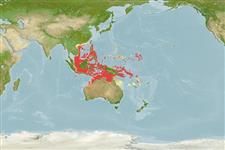Common names from other countries
Environment: milieu / climate zone / depth range / distribution range
Ecologia
marino associati a barriera corallina; non migratori; distribuzione batimetrica 5 - 147 m (Ref. 90102). Tropical; 22°N - 20°S, 104°E - 172°E
Indo-West Pacific: Philippines, Indonesia, New Guinea, northeastern Australia (Cape York to northern Great Barrier Reef) Belau, Truk, Caroline Islands, Marshall Islands, and the Solomon Islands. Reported from Malaysia (Ref. 5756).
Length at first maturity / Size / Peso / Age
Maturity: Lm ?, range 42 - ? cm
Max length : 75.0 cm TL maschio/sesso non determinato; (Ref. 5222); peso massimo pubblicato: 1.2 kg (Ref. 40637)
Spine dorsali (totale) : 7 - 8; Raggi dorsali molli (totale) : 10 - 12; Spine anali: 3; Raggi anali molli: 8.
Inhabits drop-offs and steep channel slopes (Ref. 9710). Very little has been published on its biology. Reported to forage in groups of two or three for rock- and sand living crustaceans and fishes. Rare in most areas (Ref. 9710). In the Hong Kong live fish markets (Ref. 27253).
Life cycle and mating behavior
Maturities | Riproduzione | Spawnings | Egg(s) | Fecundities | Larve
Heemstra, P.C. and J.E. Randall, 1993. FAO Species Catalogue. Vol. 16. Groupers of the world (family Serranidae, subfamily Epinephelinae). An annotated and illustrated catalogue of the grouper, rockcod, hind, coral grouper and lyretail species known to date. Rome: FAO. FAO Fish. Synop. 125(16):382 p. (Ref. 5222)
IUCN Red List Status (Ref. 130435)
CITES (Ref. 128078)
Not Evaluated
Threat to humans
Reports of ciguatera poisoning (Ref. 5222)
Human uses
Pesca: scarso interesse commerciale
Strumenti
Special reports
Download XML
Fonti Internet
Estimates based on models
Preferred temperature (Ref.
115969): 26.6 - 29.3, mean 28.7 (based on 1890 cells).
Phylogenetic diversity index (Ref.
82804): PD
50 = 0.5078 [Uniqueness, from 0.5 = low to 2.0 = high].
Bayesian length-weight: a=0.01023 (0.00643 - 0.01629), b=3.03 (2.90 - 3.16), in cm Total Length, based on LWR estimates for this species & (Sub)family-body (Ref.
93245).
Trophic level (Ref.
69278): 4.0 ±0.66 se; based on food items.
Resilienza (Ref.
120179): Basso, tempo minimo di raddoppiamento della popolazione 4.5 - 14 anni (Preliminary K or Fecundity.).
Fishing Vulnerability (Ref.
59153): Moderate to high vulnerability (50 of 100).
